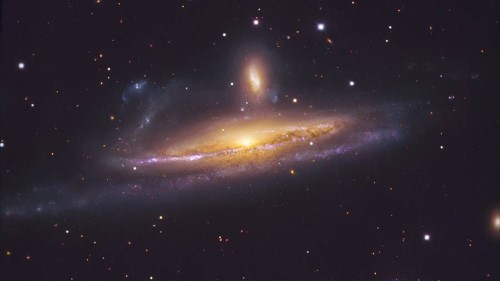Research
Published 15 January 2018NZ study: what holds our universe together?

Kiwi researchers have set out to shed fresh light on one of the most enduring questions about our universe: what holds it together?
And no Star Wars fans - it's not the force.
Originally published in the New Zealand Herald on 15 January 2018
We know our Sun is one of billions of stars in our local galaxy, the Milky Way, which is itself one of billions of galaxies in the universe.
Less well understood, however, was the cosmic fabric that binds the universe.
"Astonishingly, the most promising answer to this question is the idea that galaxies have 'skeletons' of dark matter outweighing all of the stars and gas inside them, but we have no idea what dark matter actually is," University of Auckland cosmologist Professor Richard Easther said.
While it's believed to make up 80 per cent of the mass of galaxies, dark matter has never been directly observed, and it doesn't emit light or energy.
"What we do know is that dark matter isn't made out of atoms, or any known fundamental particles – it must be something completely new," Easther said.
"On top of that, simple dark matter theories are increasingly boxed in by experimental results, so astrophysicists are looking at new ideas."
One of those most exciting was what's called "ultralight dark matter", where the dark matter behaves like a fluid, with pressure as well as a gravitational field.
"This additional complexity makes it harder to understand, but we are figuring out how to make detailed predictions for this model."
In a new study, awarded a $910,000 Marsden Fund grant, Easther, Auckland post-doctoral researcher Shaun Hotchkiss, and colleagues will use models to try to solve questions they've formulated.
"We set up the problem with pencil and paper, but we solve equations describing large quantities of dark matter on a computer - a process something like modelling the atmosphere for a weather forecast.
"There are a lot of big computer simulations that model the origin and interaction of galaxies in the expanding universe – these are some of the most complex computer simulations ever run, and the largest of them take weeks on some of the world's biggest supercomputer facilities."
University of Auckland cosmologist Professor Richard Easther. Photo: NZ Herald
One of the reasons ultralight dark matter had not received more attention was that its combination of pressure and gravity - and its complex interactions of small and large scale behaviour - made it more challenging to model on a computer.
"So one of our key goals will be to develop a powerful computer code for making these simulations work efficiently.
"What we plan to do is to focus on scenarios where ultralight dark matter can possibly behave different from 'regular' dark matter."
Easther's team aimed to focus on the dynamics of so-called "dwarf galaxies", which can be composed of as little as 100 million stars, compared with the 200 to 400 billion within our Milky Way.
"We have a structured "ladder" of problems that will allow us to build up the code slowly, and we plan to release it to the community so anyone can use it in their work," he said.
"Writing the computer codes to do the simulations will be hard but the Auckland group has a lot of experience modelling the behaviour of exotic matter in the expanding universe, so we have a lot of tricks up our sleeves."
The eventual findings could prove greatly important for the field, he said.
"Dark matter is a huge deal for both astronomy and particle physics and we are helping to the solve the huge puzzle it represents – whether or not the ultralight dark matter hypothesis is right, putting it to the test will mark a big step forwards."
Additional information: See the original NZ Herald article written by Jamie Morton
RESEARCHER
Professor Richard Easther
ORGANISATION
The University of Auckland
FUNDING SUPPORT
Marsden Fund
CONTRACT OR PROJECT ID
UOA1727
